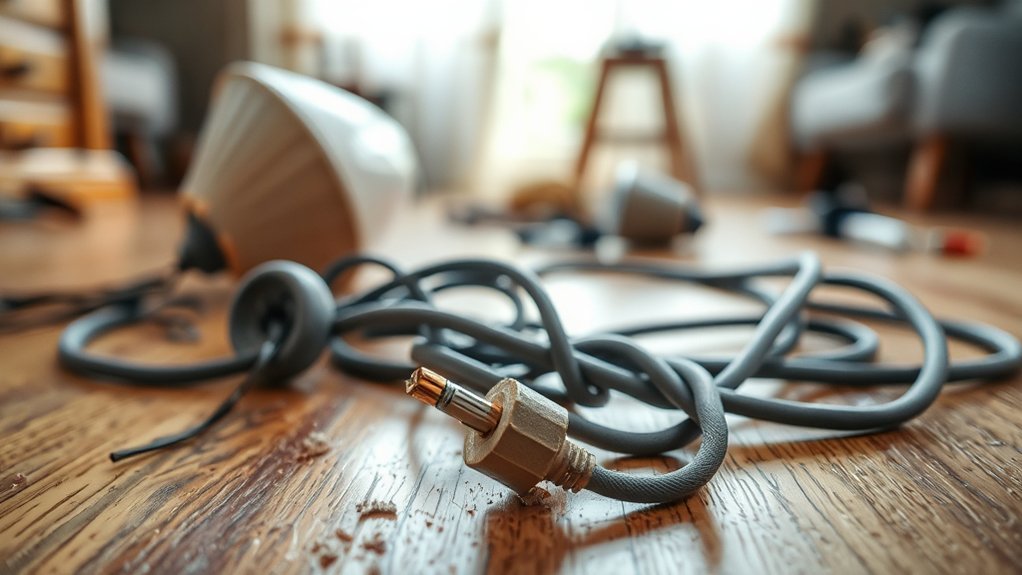Cord safety is a vital issue that affects many households across the U.S., particularly for vulnerable groups like young children and the elderly. These populations face real dangers from tripping and strangulation hazards posed by everyday items. Understanding the causes and risk factors behind these hazards can help you take proactive measures. Are you aware of the common sources of hazardous cords lurking in your home?
Understanding Cord-Related Hazards
When you think about everyday hazards, cord-related dangers mightn’t immediately come to mind, yet they pose significant risks in various environments.
Poor cord management can lead to tripping hazards, particularly in homes with children. Loose cords can easily become entangled, creating potential strangulation risks for curious toddlers.
Implementing effective cord management strategies, like using cord clips or organizers, enhances child safety by keeping cords out of reach and reducing chaos.
It’s essential to assess your surroundings regularly, ensuring that cords are secured and not left hanging.
Demographics Most Affected by Cord Accidents
While cord accidents can affect anyone, certain demographics are particularly vulnerable, especially young children and the elderly.
Injury statistics reveal that children aged 0-4 are at the highest risk, as they often explore their environment without awareness of potential dangers. The elderly, on the other hand, face heightened vulnerability due to mobility challenges and potential cognitive impairments.
Children aged 0-4 and the elderly are particularly vulnerable to cord accidents due to exploration and mobility challenges.
These age groups account for a significant percentage of cord-related injuries, highlighting the need for targeted safety measures. By understanding these demographics, we can advocate for safer environments.
Your awareness and action can help protect those most at risk, ensuring that everyone can navigate their spaces without the threat of cord accidents. Empowering ourselves with knowledge is the first step toward liberation from such hazards.
Common Sources of Hazardous Cords in the Home
Understanding the demographics most affected by cord accidents underscores the importance of recognizing common sources of hazardous cords in the home. Proper cord management and storage can greatly reduce risks. Here are some common culprits:
| Source | Risk Level | Prevention Tips |
|---|---|---|
| Extension cords | High | Use only as needed |
| Charging cables | Moderate | Store neatly |
| Appliance cords | Moderate | Avoid tangles |
| Decorative lights | High | Secure out of reach |
Preventive Measures for Cord Safety
To guarantee a safer home environment, implementing preventive measures for cord safety is essential.
Start with effective cord management; secure cords out of reach and use cord clips or organizers to minimize tangling. Regularly inspect cords for wear and tear, replacing any damaged ones immediately.
Incorporate safety education into your routine by discussing cord hazards with family members, especially children. Teach them to recognize dangerous situations, like loose cords near walkways.
Consider using cord covers or sleeves to reduce exposure to sharp edges. By actively engaging in these practices, you create a more liberated space where everyone can thrive without the fear of cord-related accidents.
Resources for Parents and Caregivers
As you navigate the challenges of keeping your home safe, especially regarding cords, there are valuable resources available for parents and caregivers. Organizations like the American Academy of Pediatrics provide thorough safety education on cord management, highlighting best practices to reduce risks.
Online platforms, such as Safe Kids Worldwide, offer tips and product recommendations specifically designed to secure cords in your environment. You can also find local workshops focused on child safety, which emphasize the importance of proactive measures.
Connecting with community support groups can further enhance your awareness and strategies. By leveraging these resources, you empower yourself to create a safer home, ensuring your child’s well-being and freedom to explore without unnecessary hazards.
Frequently Asked Questions
What Should I Do if My Child Is Injured by a Cord?
If your child’s injured by a cord, immediately call emergency services. Assess the injury, apply necessary first aid, and document everything. Focus on injury prevention by removing hazards and educating yourself about safe environments.
Are There Specific Cord Safety Regulations in the US?
Yes, there are cord safety regulations in the US, aiming to prevent accidents. An overview reveals standards set by organizations like ASTM and CPSC, ensuring products minimize risks and promote a safer environment for children.
How Can I Report a Cord-Related Accident?
To report a cord-related accident, contact your local safety authority or consumer protection agency. Follow their safety protocols for accident reporting, ensuring you provide detailed information to help improve future safety measures and prevent incidents.
What Are the Signs of Cord-Related Injuries?
When you spot a tangled vine, you recognize its danger. Similarly, cord entanglement signs include difficulty breathing, skin discoloration, or unusual movements. Symptoms recognition is crucial for ensuring immediate help and preventing serious injuries.
Can Pet Cords Also Pose Safety Risks?
Yes, pet cords can pose safety risks. Proper cord management guarantees your pets don’t chew or entangle themselves in electric cords, which is essential for pet safety. Always secure cords to prevent accidents and injuries.
Conclusion
In summary, prioritizing cord safety is like putting up guardrails on a winding road; it protects vulnerable individuals from potential hazards. By understanding the risks associated with cords and actively implementing preventive measures, you can create a safer environment for everyone in your home. Regular assessments and the use of effective management tools not only minimize accidents but also promote peace of mind. Stay vigilant and proactive, because a secure home is a happy home.
